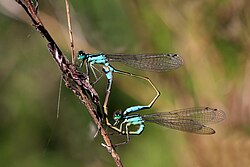This article needs additional citations for verification. (November 2013) |

(Ischnura elegans) mating
In biology, mating is the pairing of either opposite-sex or hermaphroditic organisms for the purposes of sexual reproduction. Fertilization is the fusion of two gametes.[1] Copulation is the union of the sex organs of two sexually reproducing animals for insemination and subsequent internal fertilization.[2] Mating may also lead to external fertilization, as seen in amphibians, fishes and plants. For most species, mating is between two individuals of opposite sexes. However, for some hermaphroditic species, copulation is not required because the parent organism is capable of self-fertilization (autogamy); for example, banana slugs.
The term mating is also applied to related processes in bacteria, archaea and viruses. Mating in these cases involves the pairing of individuals, accompanied by the pairing of their homologous chromosomes and then exchange of genomic information leading to formation of recombinant progeny (see mating systems).
- ^ The Free Dictionary. "'Fertilization' – definition of". Farlex, Inc. Archived from the original on 28 May 2022. Retrieved 25 January 2014.
- ^ Naguib, Marc (19 April 2020). Advances in the Study of Behavior. Academic Press. ISBN 978-0-12-820726-0.